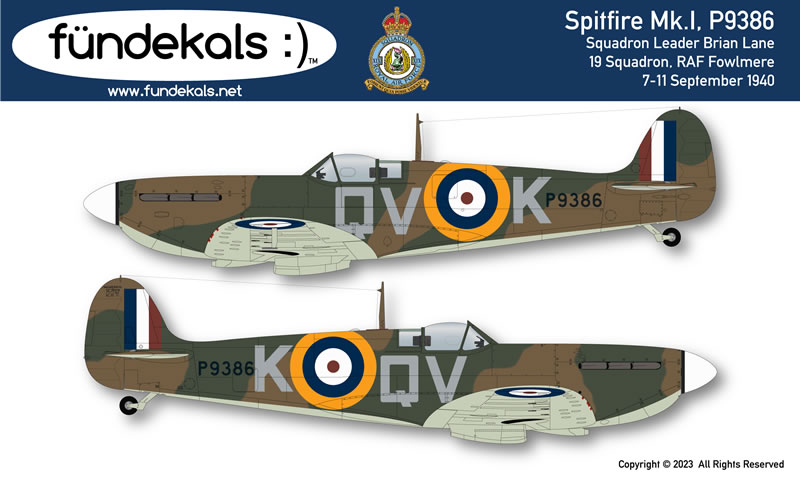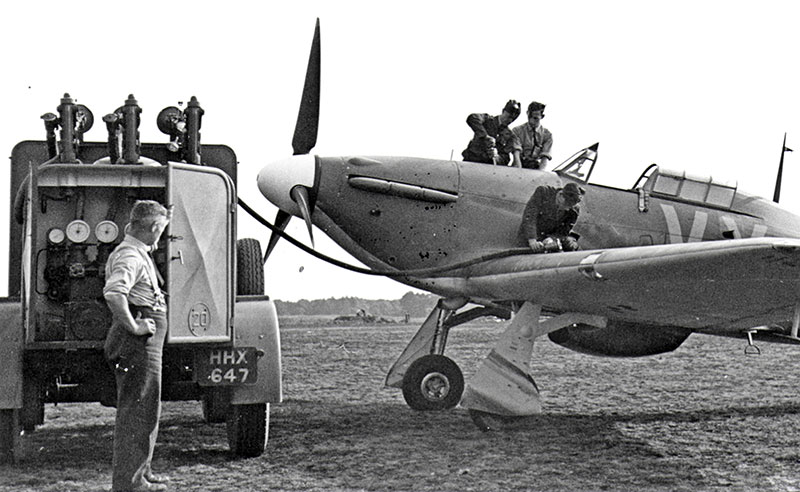|
What Color Was the Spinner on Spitfire P9386/QV-K?

by Jennings Heilig
Squadron Leader Brian Lane is one of the most famous names from the Battle of Britain. He assumed command of 19 Squadron at RAF Fowlmere on 5 September 1940 during the most crucial days of the battle. During that time, Lane regularly flew Spitfire Mk.I P9386, coded QV-K. Lane’s aircraft, with its oversized fuselage roundels and huge blocky squadron codes has become one of the most iconic of the Battle of Britain, yet 83 years on, it has remained one of the most controversial among modelers, decal and profile artists, and model manufacturers due to its mysterious light colored spinner.
In September of 1940, the RAF specified Night as the color for fighter spinners, and the vast majority of Spitfires and Hurricanes that participated in the battle were thus finished. But Lane’s aircraft stands out, with its light colored spinner, albeit retaining its Night spinner base plate. So what color was Lane’s spinner, and why?
Conventional wisdom, going back to the 1960s, has maintained that it was yellow, purportedly based on the aircraft having been assigned to an OTU as a trainer, where such colorful spinners were common. But in the case of P9386 the known facts about her history simply do not support that proposition. We know for a fact that P9386 was the 569th Spitfire built, and left the Supermarine works in Southampton Eastleigh on 1 March 1940. She spent a few days doing airspeed trials work at Supermarine before delivery to 38 Maintenance Unit on 6 March. She remained at 38 MU until 11 May 1940, when she was issued to 257 Squadron at RAF Hendon. She remained with 257 until the squadron converted to Hurricanes, and was passed on to 19 Squadron on 3 September 1940.
Brian Lane flew P9386 regularly during early to mid-September. As noted above, Lane assumed command of 19 Squadron on 5 September (just two days after P9386 arrived at Fowlmere). The aircraft remained with 19 Squadron for only a bit over three weeks, moving on to 152 Squadron at RAF Warmwell on 26 September. The aircraft remained with 152 Squadron until 23 March 1941, when she was assigned to 58 OTU - her first of several assignments as a trainer in an OTU. She remained with various OTUs until an accident claimed her on 5 May 1944. So the theory that P9386 had a yellow spinner when she was with 19 Squadron because of having been in an OTU is simply not possible.
What color was the spinner during the 23 days P9386 was assigned to 19 Squadron, and why? Black and white photos of the period are frustratingly inconsistent. In the most well known photo of Lane’s aircraft, a left broadside of her taken in bright sunshine, the spinner certainly appears white. It is much lighter than the known yellow of the roundel's outer ring. It is also lighter than the Sky lower surfaces that had been applied earlier in the summer of 1940.
We have to look elsewhere for more clues. Beginning in August 1940, around the time of Adlertag, the Luftwaffe implemented the extensive use of yellow as an IFF measure. The huge numbers of fighters in the skies over southern England made quick visual identification of friend vs. foe critical. With sometimes hundreds of fighters mixing it up, it would have been far too easy to simply roll in on a single-engined fighter and start blasting away, and friendly fire incidents were not uncommon. To combat this, the Luftwaffe began painting its fighter aircraft with prominent yellow noses, and sometimes yellow wing tips and portions of the vertical fin as a quick way to distinguish Luftwaffe comrades from the enemy's Spitfires and Hurricanes. The RAF in 1940 generally did not use yellow as an identification color, with the exception of the outer ring on the fuselage roundel. If you were a Bf 109 pilot over England, and you found yourself in a dogfight, you simply wouldn't shoot at anything with a yellow nose. Conversely, if you were an RAF Spitfire or Hurricane pilot and you saw an airplane with a yellow nose, you killed it. Period.
At precisely the same time that S/L Lane was flying P9386 with its light colored spinner, S/L Peter Townsend of 85 Squadron based at RAF Croydon had his spinner painted white as a quick ID for his squadron to identify the boss in the air. Why white and not yellow? Well, if you know the bad guys are painting the entire front ends of their airplanes yellow, and you're going up against swarms of "yellow-nosed bastards" bent on destroying you and your country, why on earth would you paint the nose (even just the spinner) of your airplane yellow? It defies common sense. White is easier to see at a distance than yellow, and if your spinner is white, there's almost no chance one of your comrades is going to start shooting at you, thinking you're one of the enemy. Is it coincidence that Brian Lane's Spitfire had a light colored spinner at precisely the same time that Townsend had a white spinner on his Hurricane? We think not.

S/L Peter Townsend’s Hurricane Mk.I, P3854, VY-Q, taken on 21 September 1940
There are other instances of light colored spinners in use during the Battle of Britain, not a single one of which has ever been positively verified as having been yellow. Some references from the 1960s and 70s showed yellow spinners on Hurricanes during this period, but all have since been discounted. Another well known example of a colored spinner is the 66 Squadron Spitfire Mk.I R6800, coded LZ-N, which had a red spinner.
Lacking a period color photo of Lane's Spitfire (which, recall, was only assigned to 19 Squadron for 23 days), can we ever know for certain what color the spinner was? Of course not. But we can do some research and easily disprove the long-held conventional wisdom that says P9386's spinner was yellow because the aircraft had been in an OTU before Lane got it. Given that we know that other squadron leaders had their spinners painted white (or red, or Sky) at the exact same time that Lane was flying P9386, the photographic evidence clearly points to Lane's being white as well.
Text & Title Image Copyright © 2023 by Jennings Heilig
Page Created
3 January, 2023
Page Updated
3 January, 2024
Back to Reference Library
|
Home |
What's New |
Features |
Gallery |
Reviews |
Reference |
Forum |
Search